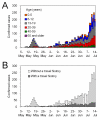Pros and cons of estimating the reproduction number from early epidemic growth rate of influenza A (H1N1) 2009
- PMID: 20056004
- PMCID: PMC2821365
- DOI: 10.1186/1742-4682-7-1
Pros and cons of estimating the reproduction number from early epidemic growth rate of influenza A (H1N1) 2009
Abstract
Background: In many parts of the world, the exponential growth rate of infections during the initial epidemic phase has been used to make statistical inferences on the reproduction number, R, a summary measure of the transmission potential for the novel influenza A (H1N1) 2009. The growth rate at the initial stage of the epidemic in Japan led to estimates for R in the range 2.0 to 2.6, capturing the intensity of the initial outbreak among school-age children in May 2009.
Methods: An updated estimate of R that takes into account the epidemic data from 29 May to 14 July is provided. An age-structured renewal process is employed to capture the age-dependent transmission dynamics, jointly estimating the reproduction number, the age-dependent susceptibility and the relative contribution of imported cases to secondary transmission. Pitfalls in estimating epidemic growth rates are identified and used for scrutinizing and re-assessing the results of our earlier estimate of R.
Results: Maximum likelihood estimates of R using the data from 29 May to 14 July ranged from 1.21 to 1.35. The next-generation matrix, based on our age-structured model, predicts that only 17.5% of the population will experience infection by the end of the first pandemic wave. Our earlier estimate of R did not fully capture the population-wide epidemic in quantifying the next-generation matrix from the estimated growth rate during the initial stage of the pandemic in Japan.
Conclusions: In order to quantify R from the growth rate of cases, it is essential that the selected model captures the underlying transmission dynamics embedded in the data. Exploring additional epidemiological information will be useful for assessing the temporal dynamics. Although the simple concept of R is more easily grasped by the general public than that of the next-generation matrix, the matrix incorporating detailed information (e.g., age-specificity) is essential for reducing the levels of uncertainty in predictions and for assisting public health policymaking. Model-based prediction and policymaking are best described by sharing fundamental notions of heterogeneous risks of infection and death with non-experts to avoid potential confusion and/or possible misuse of modelling results.
Figures




References
-
- Fraser C, Donnelly CA, Cauchemez S, Hanage WP, Van Kerkhove MD, Hollingsworth TD, Griffin J, Baggaley RF, Jenkins HE, Lyons EJ, Jombart T, Hinsley WR, Grassly NC, Balloux F, Ghani AC, Ferguson NM, Rambaut A, Pybus OG, Lopez-Gatell H, Alpuche-Aranda CM, Chapela IB, Zavala EP, Guevara DM, Checchi F, Garcia E, Hugonnet S, Roth C. WHO Rapid Pandemic Assessment Collaboration. Pandemic potential of a strain of influenza A (H1N1): early findings. Science. 2009;324:1557–1561. doi: 10.1126/science.1176062. - DOI - PMC - PubMed
-
- Boëlle PY, Bernillon P, Desenclos JC. A preliminary estimation of the reproduction ratio for new influenza A(H1N1) from the outbreak in Mexico, March-April 2009. Euro Surveill. 2009;14(19) pii: 19205. - PubMed
-
- White LF, Wallinga J, Finelli L, Reed C, Riley S, Lipsitch M, Pagano M. Estimation of the reproductive number and the serial interval in early phase of the 2009 influenza A/H1N1 pandemic in the USA. Influenza Other Respi Viruses. 2009;3:267–276. doi: 10.1111/j.1750-2659.2009.00106.x. - DOI - PMC - PubMed
-
- Nishiura H, Castillo-Chavez C, Safan M, Chowell G. Transmission potential of the new influenza A(H1N1) virus and its age-specificity in Japan. Euro Surveill. 2009;14(19) pii: 19205. - PubMed
Publication types
MeSH terms
LinkOut - more resources
Full Text Sources
Medical
Miscellaneous

